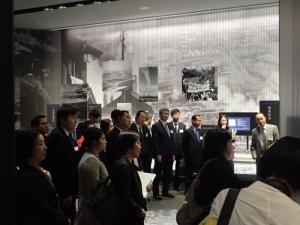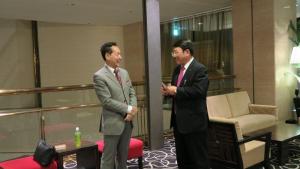Home > Information Dissemination and Awareness-raising > Fiscal Year 2015 > “ASEAN Environment Forum in Mie” Takes Place
Main content starts here.
Update:March 30, 2016
“ASEAN Environment Forum in Mie” Takes Place
On May 26 and 27, 2016, the G7 Summit is held in Ise Shima, Mie Prefecture. The ASEAN Environment Forum in Mie was organized as part of a week-long event to mark the 100 remaining days before the Ise-Shima Summit while celebrating the 25th anniversary of the establishment of ICETT, the International Center for Environmental Technology Transfer.
Date: Friday, February 12, 2016, 14:30 – 17:50
Venue: Ise Hall (4th Floor) at Yokkaichi Miyako Hotel
Program (1) : Panel discussion on “Sustainable Economic Growth in ASEAN Countries”
Coordinator: Eikei Suzuki, Governor of Mie Prefecture
Panelists: Ambassadors to Japan and other representatives from ASEAN countries
Program (2) : Environmental lecture on “Global Links of Life – A View from Space”
Lecturer: Mamoru Mohri, former astronaut and
Chief Executive Director of the National Museum of Emerging Science and Innovation (Miraikan)
Panel discussion :
 (Panel discussion)
(Panel discussion)
The ASEAN Economic Community (AEC) was established last year, which is expected to bring further economic growth to ASEAN countries. In these circumstances, a panel discussion was organized to exchange the views of ambassadors to Japan and other embassy representatives from ASEAN members about the present and future of the economy and the environment of these countries. Taking advantage of this opportunity as the host venue of the Summit, Mie Prefecture aims to become better known to the world and strengthen its ties with the ASEAN nations as an important region for its international promotion, while increasing the attendants’ interest in the region, which is showing remarkable economic development.
According to the ambassadors and other embassy representatives from all the ten ASEAN countries, many of these countries have shown high economic growth rates because of their industrial concentration policies, such as the development of special economic zones and industrial areas, and their considerable investment in building infrastructure including railways and roads for transportation. At the same time, they have made environmental efforts to protect marine resources, forests, and wildlife. Although the event was too short to learn about the situation of all the countries, it was a good opportunity to recognize the situation of their economic growth and examine environmental issues, which are caused by their growth, and ways how Japan can contribute to solving these problems.
At the end, Governor Suzuki as the coordinator concluded the discussion, saying that he got a strong impression that all the ten ASEAN nations are determined to develop close ties and cooperate with each other. He also said that he didn’t feel it was necessary to immediately develop ties with all ASEAN countries, but starting exchanges first with one of them might provide Mie with access to the entire region in the long term.


(Eikei Suzuki, Governor of Mie Prefecture) ( Visit to Yokkaichi Pollution and Environmental
Museum for Future Awareness)
Environmental lecture :
Mr. Mamoru Mohri delivered a lecture. He was the first Japanese astronaut who flew to space aboard a Space Shuttle. He traveled to space in 1992 and 2000. This event took place on February 12, the same day he flew on his 2nd mission 16 years ago. The lecture provided an opportunity to listen to his views as a man who saw Earth, the home planet of all mankind, floating in the vast emptiness of space. Following the lecture, guests had a chance to ask Mr. Mohri questions about space trips and whether or not he would like to go back to space again. His bright and gentlemanly personality touched everybody while he interacted with the audience and answered these questions.


(Mr. Mamoru Mohri at an environmental lecture) (Mr. Mamoru Mohri talks with the Yokkaichi Mayor)
Mr. Mohri spoke as follows at the lecture.
“Looking out the window of the International Space Station (ISS) at Earth, I could see cities and towns where people live, and places where oil and coal are being burned. When I flew on my 2nd mission in 2000, eight years after my first mission in 1992 into space, I saw changes in the global environment between the two missions. However, Earth still looked blue and beautiful. The beauty gave me an impression that, beside Earth, there is no other place in the universe where life can exist.”
“It is the era when astronauts stay in space all the time and the whole environment on Earth can be observed in real time, or the age when the way life is connected across the globe can be seen. Not only countries but also individuals should come up with and share ideas, taking advantage of science and technology including the Internet. The National Museum of Emerging Science and Innovation I work for is going to host an international convention next year called the Science Centre World Summit (SCWS), an event where representatives from science centers and museums all over the world meet. Its theme is ‘Connecting the World for a Sustainable Future’. We would like to send messages about how Japanese science and technology can contribute to the future of the world.”
In conclusion, the Ise-Shima Summit related forum was a great opportunity to give ICETT, Mie Prefecture, and the Ise-Shima Summit wider publicity.
ICETT would like to express its gratitude to the ambassadors to Japan and other embassy representatives from ASEAN countries for their participation and cooperation in this forum. ICETT would also like to express its gratitude to the ASEAN-Japan Centre, the United Nations Centre for Regional Development, the Chubu Economic Federation, and the Yokkaichi Chamber of Commerce and Industry, which supported and cooperated in the forum by providing advice, information, and materials.








